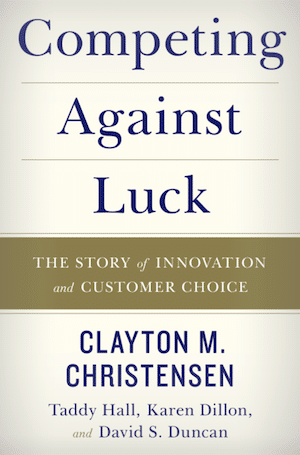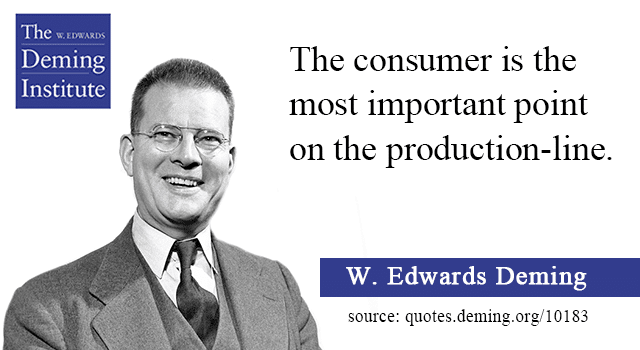By John Hunter, author of Management Matters: Building Enterprise Capability.
In Clayton Christensen’s book, Competing Against Luck, the authors delve into the importance of gaining a deep understanding of what your customers desire. The book lays out a Theory of Jobs to be Done in a very compelling way. This is a great example of extending Deming’s ideas with a great deal of useful content on how to effectively become more customer focused.
This article, by the authors of the book, provides a good introduction to the topic: Know Your Customers’ “Jobs to Be Done”.
We all have many jobs to be done in our lives. Some are little (pass the time while waiting in line); some are big (find a more fulfilling career). Some surface unpredictably (dress for an out-of-town business meeting after the airline lost my suitcase); some regularly (pack a healthful lunch for my daughter to take to school). When we buy a product, we essentially ‘hire’ it to help us do a job. If it does the job well, the next time we’re confronted with the same job, we tend to hire that product again. And if it does a crummy job, we ‘fire’ it and look for an alternative.
The article and the book discuss the insight gained by understanding what your potential customers desire (what job the customers are trying to accomplish), and what prevents them from becoming customers.
That realization helped Moesta and his team begin to grasp the struggle potential home buyers faced. ‘I went in thinking we were in the business of new-home construction,’ he recalls. ‘But I realized we were in the business of moving lives.’
This is reminiscent of W. Edwards Deming’s discussion on truly understanding the needs of customers and also Russell Ackoff’s ideas on seeking solutions by looking at the larger containing system. Often innovative solutions can be found if you expand the scope of what you see as the system. By expanding the scope of your vision from your product (a house) to the larger system, you can learn that the customer’s objections are not their primary objections. It isn’t concern about the new house, or the allure of competitor’s offerings, that stops people from buying a house from you, but worries about all the hassles involved with moving.
If you see your job from the customer’s perspective, you may change the scope of your offerings. You can add services that help the potential customer choose you. In the book, the authors explore this concept in detail. They discuss how an online university changed its processes to address the issues potential customers faced in the “hiring” process. They changed not the product (education), but the processes that supports potential students making the decision to hire Southern New Hampshire University.
Competing Against Luck is packed with valuable ideas:
Throughout this book we will refer to jobs in shorthand simplistic terms for ease of reference – but it’s important to emphasize that a well-defined job is multilayered and complex. And that is actually a good thing. Why? Because it means that perfectly satisfying someone’s job likely requires not just creating a product, but engineering and delivering a whole set of experiences that address the many dimensions of the job and integrating those experiences into the company’s processes. When you’ve done that well, it’s almost impossible for competitors to copy.
There’s a great deal of insight in this quote. The understanding of the complex needs of customers and the importance of managing the organization as a system to consistently delight customers is integrated throughout the book (and Clayton Christensen’s other work).
For an appreciation for how detailed an understanding Jobs to be Done seeks to capture, see: The Jobs to be Done Mattress Interview.
Simply put, customers want the ability to create a 1/4″ hole in wood, they don’t want a drill. A drill is a means of getting a 1/4″ hole. If you focus on making a better drill, you may miss other solutions.
Dr. Deming would talk about the importance of knowing what business you are in. If you are in the business of making carburetors, you are at risk of technological innovation putting you out of business. If you are in the business of injecting fuel within internal combustion engines, you can then produce fuel injectors that eliminate the need for catalytic converters.
Deeply understanding a customer’s real Job to Be Done can be challenging in practice. Customers are often unable to articulate what they want; even when they do describe what they want, their actions often tell a completely different story.
Such valuable insight is a wonderfully repeating pattern in Competing Against Luck. Dr. Deming talked about these same ideas. Customers don’t innovate, it takes a business with expertise and a deep appreciation for what customers seek to accomplish to innovate.
Competing Against Luck provides useful concepts and strategies to create a deeply customer-focused organization. Understanding and applying them will improve your ability to make the customer the most important part of your processes. Both W. Edwards Deming and Clayton Christensen understand that the customer is part of the system in a way that most others don’t appreciate.
You must design processes that incorporate the complete scope of providing products and services. Putting the product or service into the customer’s hand should not be seen as the end of the process. We need to pay attention to how our customers use our product and not see that as something outside our sphere of influence.
In the book, they even discuss the idea that it is important to avoid customers that seek to “hire” you when you cannot provide a good solution to their Job to be Done. If customers buy your product and are disappointed, that will impact their impression of your company and their feedback to others about your company. This is true even if they are trying to use your product for a Job to Do that you didn’t intend, which can lead to compensating behaviors/workarounds.
Whenever you see a compensating behavior, pay very close attention, because it’s likely a clue that there is an innovation opportunity waiting to be seized – one on which customers would place a high value. But you won’t even see these anomalies – compensating behavior and cobbled-together workarounds – if you’re not fully immersed in the context of their struggle.
This is a powerful concept. And it puts in concrete terms the more vague idea of understanding your customer’s desires. When you appreciate the importance of the user gemba, you know to pay close attention to customers. It is part of your responsibility to inform consumers well, so they “hire” you for the right Jobs.
Over 20 years ago I attended a seminar with Brian Joiner (Variation and Management), who told me how Toyota would watch customers at grocery stores loading shopping bags into their cars. Toyota observed that customers used various compensating methods to try and keep their bags stable for the ride home. Toyota studied potential solutions to this Job to be Done, and they introduced cargo nets to help secure loads. In another example, a tool manufacturer noticed their customers would tape the tool handles to improve comfort and grip. The toolmaker worked on improving the design based on the workarounds they saw – but they could not have done so if they hadn’t watched their customers use their product after purchase.
While this book includes ideas that are not necessarily completely new, it extends those ideas in useful ways. The Theory of Jobs created some new insight that was not understood previously when it was introduced over 20 years ago, and since then there have been many articles on and explorations of this concept. But Christensen’s book really puts the whole concept together exceptionally well.
While many in the business world associate the word ‘theory’ with something purely academic or abstract, nothing could be further from the truth. Theories that explain causality are among the most important and practical tools business leaders can have.
This is yet another wonderfully stated explanation from the book, and it echoes W. Edwards Deming’s teaching on the importance of theory.
This book is one of the most useful business books I have read in the last 10 years. I strongly recommend it.
Related: Clay Christensen’s Milkshake Marketing – Customer Focus is at the core of a well managed company – What Job Does Your Product Do? (2007)




